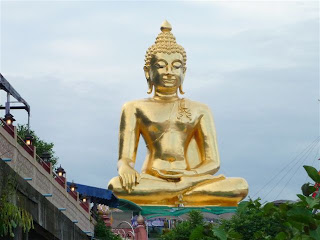
We left India ready for a vacation, and we found it in Thailand. We landed in Bangkok and the 92 degree heat felt downright comfortable compared to New Delhi 110. We met up with Guy’s parents who had come to tour Southeast Asia and meet us. For the first time in months it was a proper, modern, beautiful hotel with air conditioning and a soft mattress and a clean bathroom with shampoo samples and a TV and even bathrobes and slippers in the closet. It was luxurious
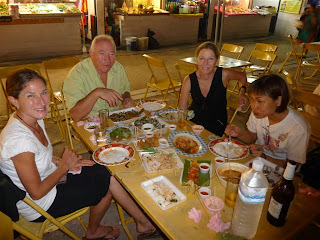
and wonderful. We had a reunion with Guy’s parents after 7 months and all went out on the streets of Bangkok in search of street food that is sold at little carts on almost every corner: noodle soups, grilled meats and hot dogs, pad thai and other fried noodles, papaya salad, duck, custom made omelets, the list goes on and on. We were spending just one night in Bangkok before heading up to the north of the country for an 8-day tour. Our first impression of Thailand was that, especially when compared to India, it was clean, organized, hospitable and functioning. The people were polite and friendly and welcoming. The streets of Bangkok seem to be just one huge outdoor market, with food vendors interspersed with carts selling t-shirts with silly slogans, Thai comfy pants, cheap sunglasses, fake watches, flip flops, and any sort of touristy knick knack or knock-off luxury product that you can imagine. Every other shop is a massage parlor, advertising traditional Thai massage or foot massage or oil massage. And there are girls, and the lady-boys, everywhere, advertising sex, the other kind of tourism that Thailand is famous for.

Because of the Red Shirt uprising in April and subsequent riots and burning of the biggest mall in Asia, there has been a major slow-down in tourism in Thailand and the economy is suffering for it. Restaurants and hotels are half-full, bars are empty, the women who do massage are all sitting outside their shops waiting for customers, and the girls dressed in tiny dresses that barely cover, are clustered outside the bars waiting for customers as well. After taking in the sights we headed to our soft, soft bed for the first comfortable night’s sleep in a long while.

We woke up the next morning and took a flight to Chiang Rai, part of the “Golden Triangle” of northern Thailand, the meeting point of Thailand, Laos and Burma (or Myanmar) , and the center of the old opium trade. The city is famous for a temple that used to house the most revered Buddah statue in Thailand’s history, the Emerald Buddah (that is really made from jade and spent some time in Chiang Rai in between trips to Laos during war, eventually making it to Bangkok where it sits today.) We landed and met our Thai guide, Nettaya, who normally works taking Israeli tour groups around Thailand and speaks much better Hebrew than me, and our driver Mr. Boon. We had our own personal “silver bullet”, a huge 9-seater silver van complete with reclining leather seats, A/C, a DVD player and TV screen that was to take us all over the north of this country over the next week. Guy’s mom, Anat, set up the trip and it was a nice change of pace for Guy and I to not plan and hustle and worry about logistics. We just sat in the chairs of the van and let it take us places….and did we ever see things.

We called it “boot camp” because Nettaya had us up every morning, ready to go by 8 and often didn’t get us back to the hotel until 8 pm. The hotels where we stayed were all aesthetic, luxurious, and pampering, and Nettaya was a great guide. She had our number from the start and figured out that Guy’s dad loves markets, especially ones where he can find a good deal. “Shuq, shuq, shuq!” (Hebrew for market), she would yell in a thai accent. She also figured out that we all LOVE to eat. So, she fed us. “Ta’im, ta’im!!!” (Hebrew for tasty, tasty) she would announce and stop the van at little road-side stands and come running back with bags of fun things to try: bamboo poles stuffed with sweet sticky rice, grilled meats, treats wrapped in banana leaves, fried crickets and other bugs, pork skins, rice cake treats, all kinds of fruits that I have never seen before, sweetened ice coffee. The more adventurous eaters, Guy and his dad, tried everything. I even ate a silk worm myself. Thais love to eat and will cook and eat anything, really, ANYTHING. So we got amongst it like locals do.

We had a really comprehensive tour of the north of Thailand. We started in Chiang Rai and from there visited the Burmese border at the town of Mae Sai, which is also a huge market town. We did a small boat trip along the Mekong River that eventually makes its way all the way north and houses the largest freshwater fish in the world, the Mekong catfish that can weigh up to 650 pounds. We also stepped foot in Laos from the boat as well for a shot of scorpion and cobra infused whiskey. We stopped at Doi Tung, visiting the royal flower garden planted in honor of the queen and drank coffee from one of the plantations that is part of her royal initiative. Before leaving the area, we visited the White Temple outside of Chiang Rai, a massive complex that is still being constructed and is the brainchild of one of Thailand’s most famous modern artists who is combining the traditional with the modern. The temple is white, and incorporates modern depictions and ideas of good vs. evil.


From Chiang Rai we made our way to the village of Mae Kham Pong, stopping along the way at a hot springs where we hard boiled eggs in the hot pools and all got foot massages. We stayed at the Tharnthong lodge, a bit of heaven on earth made of funky, hand-built country cabins on a serene, verdant property complete with free range bunnies, chickens, dogs and parrots, and did a day-hike to some waterfalls through dense rain forest. We had a local guide as well as a guy who spent the whole time hacking away at the dense vegetation with a machete in order that we could walk the trail. We saw several snakes, including a green bamboo viper, one of the most poisonous snakes in Thailand. Guy and his dad went hunting for wild mushrooms with the resort staff afterwards and we were treated to a great meal that included the mushrooms and deep fried edible flowers that they found on their hunt.


From there we drove the long winding roads to the town of Pai, a little travelers enclave that has a robust farang (or foreigner) population and caters to backpackers, musicians and artists, as well as city folk looking to get out to the country. It was kind of dead because of the tourism slowdown, but we all got massages and ate mango with sticky rice and pad thai and enjoyed the beautiful hotel. Thai massage is an ancient therapeutic practice and is a combination of stretching and intense pressure point work done by a tiny, 90-pound girl who is much stronger than she looks. It costs about $6-7 per 1 hour, and so we have been trying to get as many as we can during the trip.
From Pai, we made our way to Chiang Mai, the second largest city in Thailand, and the northern hub for tourism in Thailand. We based ourselves at a very nice hotel in the city and spent 3 days exploring the area around the city and taking in the vibrant night market at night. We spent a day at an elephant camp where elephants that used to work for the now-illegal logging industry live and perform for tourists.
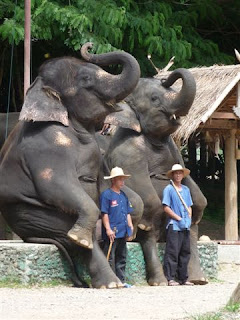
They are amazingly well-trained and can sit, lie down, kick soccer balls, throw basketballs, walk holding their tails and trunks, and even paint a picture…I am not lying, we saw an elephant paint a picture of an elephant holding a flower in its trunk. The show includes watching the elephants take a bath in the river, each with their mahout, or trainer, on their backs. After the show we all saddled up and rode elephants through the forest, rewarding them with bunches of bananas and sugar cane conveniently sold along the way, arriving in a hill tribe village where we went through the gauntlet of craft stalls, and then took a bullcart ride back to the start. At the camp we played with a 2-month old baby elephant and Guy and the elephant wrestled through the wooden fence, just like little elephant siblings would. We finished up the tour with a ride on a bamboo raft down the local river followed by an amazing lunch of grilled fish and finally we toured the lod cave, consisting of 3, 2000 meter long caves structures, admiring ancient stalagmites and stalactites, and complete with a 1700 year old coffin, and caveman art.

We spent another day hiking through a forest that led us to a hill tribe village where we got to walk through the rice fields. We visited Doi Suthep, a temple on a mountain where some of the Buddha’s ashes are said to be buried. We also visited Thailand’s highest mountain, Doi Inthanon, which rises to 2600 meters and has a pair of temples built on the peak to honor the king and queen. We spent an evening watching Muy Thai, Thai boxing, a vicious sport that is a combination of boxing and mixed martial arts and consists of 5, 3-minute rounds of intense pummeling. We spent another evening watching traditional northern Thai dancing (not as violent). On our last day, which was unplanned and guideless, we actually slept in, ate a leisurely breakfast, visited the pool and did some spa activities before heading out into the old city of Chiang Mai to check out a few of its 30(!) temples.
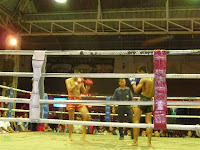

Along the way, we stopped at an umbrella factory and saw how paper parasols are made by hand by an assembly-line of mostly older women who cut bamboo with amazing accuracy. We stopped at a silk factory and saw the process from the silk worm eggs to the worms that feed on mulberry leaves, to the cocoons that are boiled to the thread that is spooled and eventually set on looms and hand woven to make fabric. We stopped at a small factory that processes cashews and other dried nuts and fruits. We stopped at an orchid farm and a leather factory and a teak factory where furniture and wooden wall paintings are carved all by hand. Of course, at each of these places was the opportunity to purchase any or all of the handicrafts being made and displayed. This place has figured out consumerism and they provide ample opportunities to purchase.


Over the week we stopped at numerous temples, or wats, each of which is ornately decorated with multiple roofs, lots of gold paint, gilded statues of the buddah, flower garlands, incense and lotus flowers, and frescos on the wall, often recounting stories of the buddah’s life. We learned about the story of the Buddah, how he was born from his mother’s side after she was visited in her dreams by a white elephant, how he took 7 steps on lotus leaves the minute of his birth and how he came to reach Nirvana. We learned about his 7 postures, one for each day of the week, and learned that Thai people make offerings and prayers to the buddah posture of the day of their birth.

Nettaya was an amazing resource for information about Thai tradition, Buddhism, local foods and customs and history. We learned about the Thai king, who is the longest reigning king in the world holding the throne for 63 years so far. He is so beloved that every town has numerous signboard pictures of him, shrines to him and all over the country you find temples and monuments built to honor him. No house or store is complete without a picture of the king, and many people pray and bow to his image, which is everywhere. We learned about how the queen started a project 30 years ago to try to stem the opium trade and helped the hill tribes, who were growing and selling opium, start other cash crop projects like coffee, tea, and flower plantations that have replaced the opium. Don’t you worry, opium is still being grown in Burma and in more remote places in the north of Thailand, but many Thais have switched to legal products and the initiative came from the royal family. We got her perspective on all the white men with Thai girls on their arm (there are many, many of these couples, some of whom have been together for years and have families, and some who are clearly just vacation girlfriends). Thai men do not treat their women so well, she said, and white men treat them better and for not much money, can afford to pay for their lives so they don’t have to work so hard, and in return, the Thai women offer companionship and whatever else.
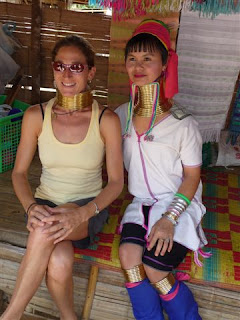
We learned about the hill tribes, different semi-nomadic groups who have come to Thailand over the past 200 years to settle from Laos, Burma, China and Tibet, and are not Thai citizens, but have a sort of residency here that allows them to be farmers and own some land and get some education and health care and achieve a much better life than they were able to living in other places. Many of these tribes have become tourist attractions, especially the tribes that have traditions that make them look interesting: the Karen women who coil brass wire around the necks of the girls born on Wednesday of full-moon and extend it as they grow, stretching out their necks; others who wrap brass wire around the women’s’ calves to make them thin and long; the Lhisu who wear plugs in their ears and funny hats. We visited several villages of these people over the course of our trip and while some of it felt exploitative, many of these people are keeping their traditions alive because it is a draw for tourists.
We saw an amazing amount of the north of Thailand and took with us an amazing amount of the foods or northern Thailand in our bellies. We flew back to Bangkok after 9 days and set up for 2 more days of touring that city with Guy’s parents before they left for Israel and we left for the south of Thailand for one last undeserved beach vacation.
 for more pics of northern thailand, do not be afraid, click here.
for more pics of northern thailand, do not be afraid, click here.